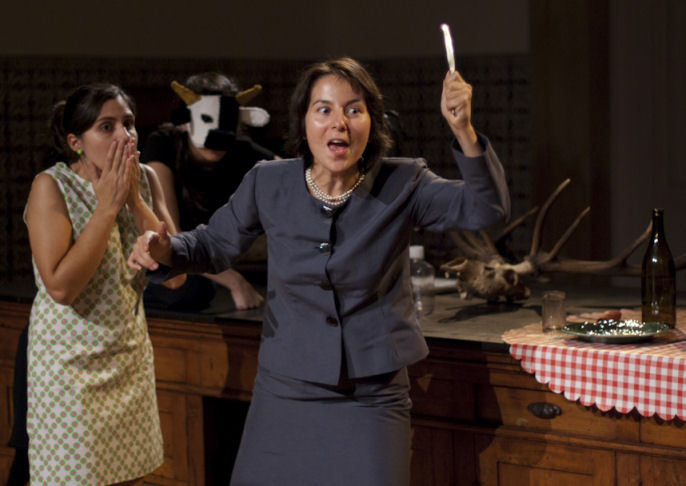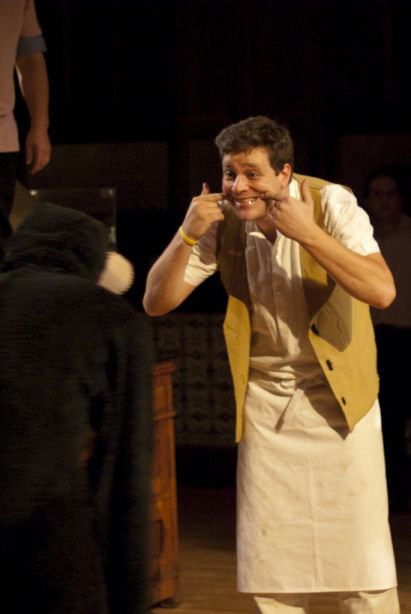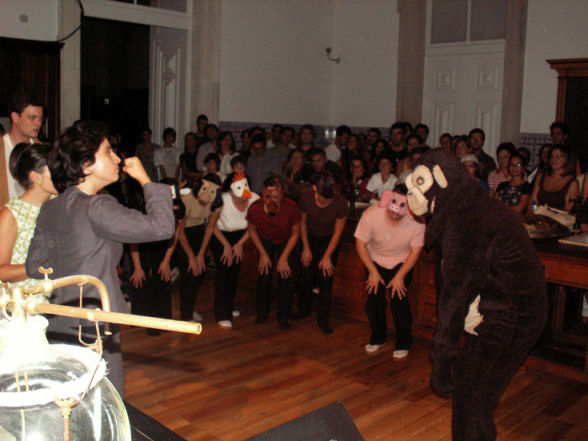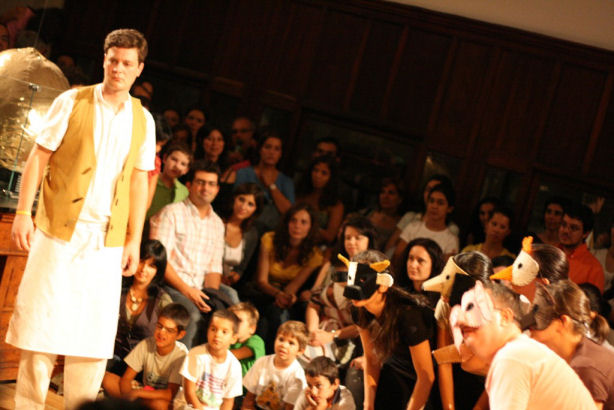Introduction
September 25th, 2009 marks the day a Portuguese theater production of a Jules Verne play reached the stage. But wait… there was no stage there. There also weren’t any actors on that nonexistent stage! Was there any theater at all? Any Verne? Well, we’d better rewind.
Every year since 2005, on the fourth Friday of September, a particular happening occurs: scientists across Europe try to get closer to other citizens. On that specific day, the so-called Researchers’ Night, [1] they generally open their research facilities to the public and engage in activities that aim to promote that union, showing and talking about their lives and work. They try to present a more “human” image, in opposition to certain strange images (e.g., mad scientist) that some people might still have when they think about scientists and what they do.
This year, the selected means for the scientists to approach the public in Portugal was theater, so the organizers of the event got in touch with several theater groups to have them collaborate in the organization of this event.
In Coimbra, one of the organizers of Researchers’ Night was the University’s Museum of Science. [2] The museum asked MARIONET, [3] a local theater group that creates science-themed plays, to collaborate in development of a play with a theme related to Charles Darwin (with 2009 being the 200th anniversary of Darwin’s birth and the 150th anniversary of the publication of his On the Origin of Species). MARIONET’s suggestion was to produce Jules Verne’s Monsieur de Chimpanzé, a play that would fit the museum’s intentions in an interesting way: it premiered in 1858, [4] the year before the publication of Darwin’s famous work, and its subject is a man’s impersonation of a chimpanzee.
Things were then settled. MARIONET would produce Verne’s Monsieur de Chimpanzé, the play was to be presented on the museum premises, and, last but not least, an additional requirement: keeping with the spirit of Researchers’ Night, the characters would be played by scientists. Ten volunteers were willing to remove their lab outfits and get into the skin of Verne’s characters. Thus the adaptation of Verne’s play to the Museum of Science and to 10 fearless scientists began.
The four challenges
This adventure presented four main challenges. Below is a brief outline of those challenges and the ways in which we addressed them.
1. Tanslating Verne's words into Portuguese
Verne’s play is a comic opera first performed at the Théâtre des Bouffes Parisiens on February 17, 1858. It has some characteristics typical of this genre, which was presented regularly at that time in that Parisian venue. The translation intended to both preserve the typical characteristics and maintain the exotic references introduced by Verne in the play. There was no intention to adapt it in any way to some kind of Portuguese reality. All specific references, such as Baptiste’s and Van Carcass’s origins, were maintained.
On the other hand, some sentences did require adaptation, particularly in parts meant for singing, to keep the rhyme that colors and enriches Verne’s text.
2. Creating a museum's environment inside a museum
The action of Monsieur de Chimpanzé takes place in a zoological museum. The Museum of Science of the University of Coimbra is located in an ancient chemical laboratory, and we decided to present the play its the most characteristic room, a chemical laboratory with furniture and some equipment from the late 19th century. This environment suited perfectly the ambience of Van Carcass’s museum. Additionally, some embalmed animals, borrowed from the zoological museum of the university, were placed in the scene to enrich the scenario of Van Carcass’s museum. The action would take place between two long lab benches about four meters apart, and the audience would be placed around this acting zone.

Rehearsal in the room of the Museum of Science, where the play was presented. (©Pedro Coelho)
3. Ten scientists to four characters
There were ten scientists to play the four character roles. How to distribute them? Because of the musical nature of the play, we decided to create a chorus to strengthen some of the sung parts of the discourse. So, four scientists would embody the characters and the other six would form the chorus. The way we integrated the chorus into the play was to make it a group of “embalmed” animals lying around the museum.
One additional adaptation was needed: there were only two men among the scientists, but three were needed for Verne’s play: Dr. Van Carcass, Baptiste, and Isidore. We decided to turn Dr. Van Carcass into a woman, mother of Etamine and an eminent scholar. Considering the cast available, this was the least disruptive option, and, given the fact that women are increasingly assuming important positions in the world of science, it resulted in a plausible update to Verne’s play.
Brazilians are the biggest immigrant community in Portugal. One of the scientists/actors happened to be Brazilian and thus was a natural choice for the role of Baptiste, Van Carcass’s Spanish servant. This, of course, required some adaptations (not originally considered in the translation) regarding Baptiste’s origins, references, and discourse, but the end product was very successful and in accordance with Verne’s idea of a somewhat exotic and comical character.
A view of the première. Several animals constitute the chorus (with the hands on their knees), and behind them is part of the audience. (©Museu da Ciência da Universidade de Coimbra)

Dr. Van Carcass is threatening to cut off Isidore’s skin, under the worried gaze of her daughter and Isidore’s lover, Etamine. Photo from a rehearsal. (©Pedro Coelho)

Baptiste tries to make friends with the chimpanzee, who is Isidore in disguise. Photo from a rehearsal. (©Pedro Coelho)
4. An operetta without music
What about the music? One of the defining characteristics of an operetta is, of course, its music. What do you do when you don’t have an orchestra? The creation of a chorus was an important step to give Sr. de Chimpanzé (its Portuguese title) a musical identity. The parts in rhyme that were sung by the actors were supported, in places, by the chorus. In other parts, the chorus engaged in a kind of musical dialogue/dispute with the actors, which created an interesting musical movement. The melodies for the musical parts were created by the ensemble, resulting from improvisations during the rehearsals.
With the aims of enriching the musical parts and introducing a bit of the scientists’ work into the play, the chorus also used laboratory instruments (pipettes, Petri dishes, etc.) to make sounds during the play.

Isidore and Baptiste at the table. Baptiste will eventually get drunk. Photo from a rehearsal. (©Pedro Coelho)
Meeting the public
Thus after 3 months of part-time rehearsals, on September 25th 2009 Sr. de Chimpanzé premièred in Coimbra, Portugal, not on a stage, and with no actors. The play was presented at 8:30 and 11:00 pm that day, with both performances sold out, meaning an audience of about 150 people per session.
It was the first time, as far as I know, that a Verne play had been translated and presented in Portugal. Verne is well-known for his adventure stories, but his dramatic work remains unknown to the vast majority of people. This production contributed to revealing that somewhat “hidden” facet of Verne.
The play’s audience was heterogeneous. There were many families with small children—a typical audience for the Museum of Science—and the play’s coloring, with its songs and stuffed animals, had a very good reception among the little ones. But with this kind of audience comes several levels of understanding. Verne’s depiction of the relation between the master and the immigrant servant, his comments about race, his irony on the similarities between man and other animals, his representation of the all-knowing scientist with high self-esteem, all these allowed a deeper interpretation of the play by the adult audience. And considering the exhibition on Charles Darwin also being presented at the museum at that time, Verne’s play was conversing in an interesting way Darwin’s theories on the origin of species and on natural selection. In fact, Verne’s words in this play (not only the central masquerade created but also some references regarding the similarities between man and apes, i.e., Comte de Buffon) enlarged the panorama of the exhibition.
Baptiste (left) and the chorus (lower right). We can see the audience “invading” the scene. (©Museu da Ciência da Universidade de Coimbra)
With all this mixing—theater in a museum, scientists as actors, a chorus of embalmed animals, laboratory equipment as musical instruments—I’m sure the exotic Verne aimed at in his operetta gained a new dimension in this Portuguese production of Monsieur de Chimpanzé.
Notes
- Researchers’ Night 2009 website: http://ec.europa.eu/research/researchersineurope/events/researchersnight09/index_en.htm ^
- Museum’s website: http://www.museudaciencia.pt ^
- MARIONET’s website: http://www.marioneteatro.com ^
- Pourvoyeur, Robert. "Jules Verne aux Bouffes Parisiens." Bulletin de la Société Jules Verne 57 (1er trimestre 1981): 2-10. ^



